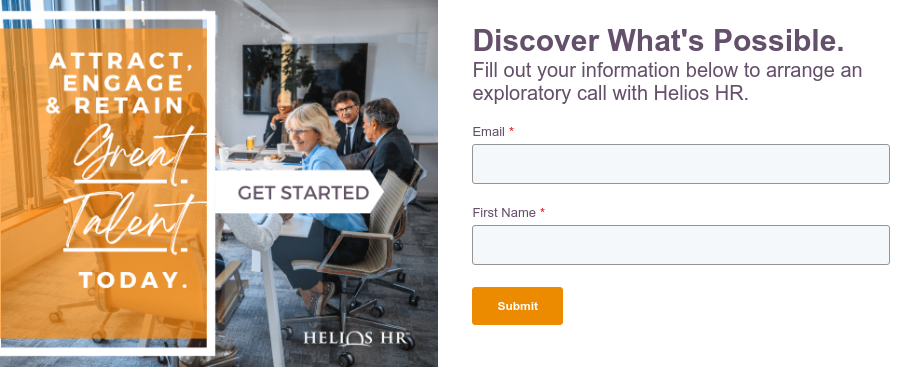By: Kim Moshlak on May 6th, 2025
Strategic Human Resource Management: Aligning HR with Business Goals
At Helios, we are often asked to define (and provide) strategic HRM to an organization in need of change. Strategic Human Resource Management is a big "buzz" term that has been used in senior leadership circles for quite some time. It is widely known to be the future of HR, is talked about at every HR conference, and is what most executives tell us they want when we work with them. But what is it? How can you determine if your HR department is working strategically? What is Strategic HRM?
Traditionally, HR departments work in a largely administrative environment, completing transactions such as hiring and onboarding employees, processing promotions and changes from part-time to full-time, managing performance review processes, and the like. All of this work needs to occur and is usually guided by a larger HR strategy. In Strategic HRM, that strategy looks beyond the immediate needs of the human resources team and instead focuses on larger business goals and business strategy.
What are the 5 steps of strategic HR management?
A strategic HR function intentionally aligns talent with the mission, vision, and values of the organization. To achieve this, leaders typically follow five key steps:
-
Assess organizational needs
This foundational step involves understanding the organization's short- and long-term goals. HR leaders must partner with senior leadership to gain clarity on what the business wants to achieve over the next 1, 3, or 5 years, and how talent plays a role in those outcomes. This includes identifying skill gaps, forecasting workforce needs, and aligning staffing plans with business objectives. -
Develop HR strategies aligned with business objectives
Once needs are understood, HR leaders can begin crafting a strategy that aligns with the company’s direction. This might include workforce planning, leadership development, succession planning, or diversity and inclusion efforts. The strategy should not only support operational efficiency but also fuel innovation and competitive advantage. -
Design talent programs and initiatives
With a strategy in place, HR must develop the programs and initiatives that support it. This can range from recruiting and onboarding processes to performance management systems, learning and development programs, and compensation structures. Each initiative should tie directly back to the strategic objectives of the business. -
Implement and execute
Strategy means little without execution. Here, HR professionals must roll out the designed programs, communicate clearly with stakeholders, and ensure adoption at all levels of the organization. This step often involves change management efforts, employee training, and strong internal communications to drive engagement. -
Measure and adjust
Strategic HR is not a "set it and forget it" approach. It requires consistent measurement and feedback loops. HR leaders should track KPIs such as employee engagement, turnover, performance outcomes, and productivity metrics to gauge the effectiveness of initiatives and make real-time adjustments as needed to stay aligned with business goals.
8 important questions to ask in Strategic HRM
To assess whether your HR function is truly strategic and aligned with your organization’s direction, ask yourself—and your leadership team—these insightful questions:
-
Is your senior HR leader sought for direction during major organizational changes, offering candid, thought-provoking questions that challenge and guide your decision-making?
A strategic HR leader doesn't just support change—they influence it by prompting leaders to reflect and realign. -
Does your organization handle change effectively, with communication strategies that help employees manage transitions and stay engaged?
Strategic HR ensures that people are not just informed about change, but equipped to thrive in the new direction. -
Is your HR department informed about industry trends and deeply familiar with your business model, market dynamics, and key competitors?
Strategic HRM means HR isn’t siloed—it’s plugged into the competitive landscape and shaping workforce strategy accordingly. -
Does your performance management approach include tools like 360-degree feedback, individual development plans, and competency modeling to drive employee growth?
These tools move performance management beyond checkboxes to real development and accountability. -
Do you use evaluation frameworks like the 9-box grid to identify high-potential employees, and are you actively developing or considering transitions for underperformers?
Strategic HR identifies talent gaps and opportunities, then acts on them to build a high-performing team. -
Are you having regular conversations with HR not only about who is capable in your organization, but also about who is willing to take on the roles critical to your future success?
Capability and willingness are both vital, and HR should help you assess and align both. -
Is your rewards and recognition system intentionally aligned with your organization’s mission, vision, and values?
Strategic rewards reinforce what matters most to your organization and motivate behaviors that support long-term goals. -
Does your HR team help measure organizational success using tools like benchmarking, balanced scorecards, engagement surveys, or other meaningful analytics?
Strategic HR is data-driven, offering leadership insights that go beyond intuition.
Strategic HR is more than just processing paperwork and helping employees with their benefits. It is a powerful management method that permits alignment of the human capital talent and the organization's direction to ensure the success of both.
Getting started with Strategic HRM
Strategic Human Resource Management is more than a trendy concept—it's a critical function that shapes the future of your organization. By aligning people strategies with business goals and continuously asking the right questions, HR can move from an administrative department to a transformative partner in organizational success.
At Helios, we believe that HR should be proactive, data-driven, and purpose-led. If you're ready to make the shift to strategic HRM, book a call with a Helios HR consultant today.




